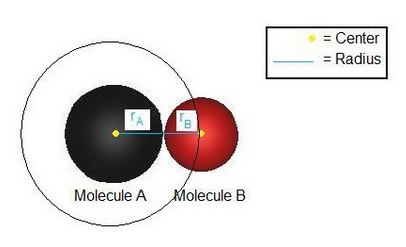Question #d1b5d
1 Answer
It will be a long answer regardless, so just scroll through and read carefully.
The difference here we'll have to probe is the mols of each gas in each flask. Having all the same masses, to some extent,
Assuming ideality, each gas from the ideal gas law will exert a pressure
#P_q# on the walls of flask#q# :
#P_A = (n_ART)/V = ((4 cancel("g CH"_4) xx "1 mol"/(16.0426 cancel"g"))("0.083145 L"cdot"atm/mol"cdot"K")("265 K"))/("9 L") = "0.6104 bars"# You can see that the molar mass comes in as an inverse relationship.
Therefore, the flask containing the gas with the lowest molar mass will contain the most mols of that gas and thus the pressure will be highest there (i.e. in flask
#bb(C)# ).
The average molar kinetic energy is given by the equipartition theorem for ideal monatomic gases:
#barK_(avg) -= K_(avg)/(n_(gas)) = N/2 RT# ,where
#N# is the number of degrees of freedom for a certain motion, and#R# and#T# are known from the ideal gas law.
#"CH"_4# needs three angles to describe its rotational motion, but#"H"_2# only needs two angles, and#"He"# has no rotational motion to consider (under the hard sphere approximation).Furthermore, all three gases will have three translational dimensions to move in (
#x,y,z# ), and we ignore vibrations (which are only significant for methane anyway).As a result,
#"CH"_4# will have#N = 3 + 3 = 6# from translation and rotation.#"H"_2# will have#N = 3 + 2 = 5# from translation and rotation.#"He"# will have only#N = 3 + 0 = 3# from translation and rotation.Therefore, we expect that methane will have the largest average molar kinetic energy, as multiplying by the largest number of degrees of freedom increases
#barK_(avg)# :
#color(blue)(overbrace(barK_(avg))^("Rotational + Translational only") = overbrace(6/2 RT)^(CH_4) > overbrace(5/2 RT)^(H_2) > overbrace(3/2 RT)^(He))# It doesn't matter how many mols of each there are, because we've divided that out and made the answer intensive.
Diffusion rate is again dependent on molar mass. The lower the molar mass, the lighter the gas and thus the faster it diffuses, simply because it moves faster.
Hence,
#bb("H"_2)# diffuses fastest.
The total kinetic energy of the molecules combined, as each gas is treated ideally, will depend only on the mass and speed:
#K = 1/2 mv^2# A good choice of speed is the root-mean-square speed:
#v_(RMS) = sqrt((3RT)/M)# .We know that the molar mass,
#M# (in#"kg/mol"# ), is smallest for#"H"_2# , and is inversely proportional to the speed (small and light = fast).Therefore,
#"H"_2# is fastest, and the sample of#bb("H"_2)# will contain the largest total kinetic energy.
We can calculate this easily without pulling out any complicated formula. You are already given the mass and volume.
#color(blue)(D) = m/V = ("4 g")/("9 L") = color(blue)("0.4444 g/L")# The densities are all the same, by construction, because the pressures vary among the flasks in such a way that the densities in each flask are the same, despite their different molar masses.
Collision frequency depends on the collision cross-section
#sigma# (and thus the size of the gas), and the reduced mass#mu# of the two colliding gases.

It is "the average number of collisions between reacting molecules per unit of time per moles of reactant", so it is not dependent on the mols of gas there are (as they have already been divided out).
Here, the same identity gases will collide with each other:
#Z_(A A) = N_A sigma_(A A) sqrt((8k_B T)/(pimu_(A A))# ,where
#N_A# ,#k_B# , and#T# are Avogadro's number (#6.022 xx 10^(23) "mol"^(-1)# ), Boltzmann's constant (#1.38065 xx 10^(-23) "J/K"# ), and temperature in#"K"# , respectively.The only numbers that matter to us are
#sigma_(A A)# and#mu_(A A)# , the collision cross-section of the gas and the reduced mass of the colliding gases.The reduced mass will involve each gas's mass as one body in a two-body collision.
#sigma_(CH_4) = "0.46 nm"^2# #sigma_(He) = "0.21 nm"^2#
#sigma_(H_2) = "0.27 nm"^2#
#mu_(CH_4//CH_4) = (16.0426^2)/(16.0426 + 16.0426) = 8.0213# #mu_(He//He) = 4.0026^2/(4.0026 + 4.0026) = 2.0013# #mu_(H_2//H_2) = (2.0158^2)/(2.0158 + 2.0158) = 1.0079# All other variables the same, the ratio of the collision frequencies are:
#Z_(CH_4)/(Z_(He)) = sigma_(CH_4)/(sigma_(He)) cdot sqrt(mu_(He)/(mu_(CH_4)))#
#= (0.46)/(0.21) sqrt(2.0013/8.0213) = 1.0941#
#Z_(CH_4)/(Z_(H_2)) = sigma_(CH_4)/(sigma_(H_2)) cdot sqrt(mu_(H_2)/(mu_(CH_4)))#
#= (0.46)/(0.27) sqrt(1.0079/8.0213) = 0.6039# So, we've shown that at the same temperature and number of particles:
#color(blue)(Z_(H_2) > Z_(CH_4) > Z_(He))#

